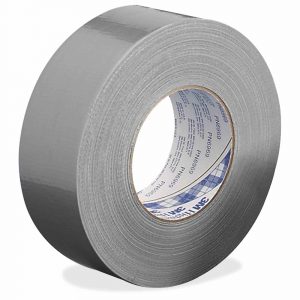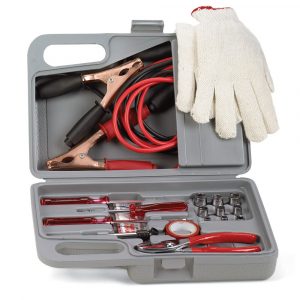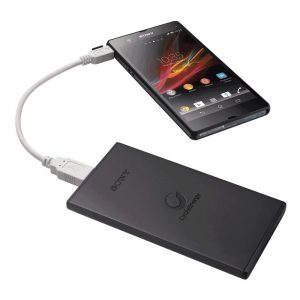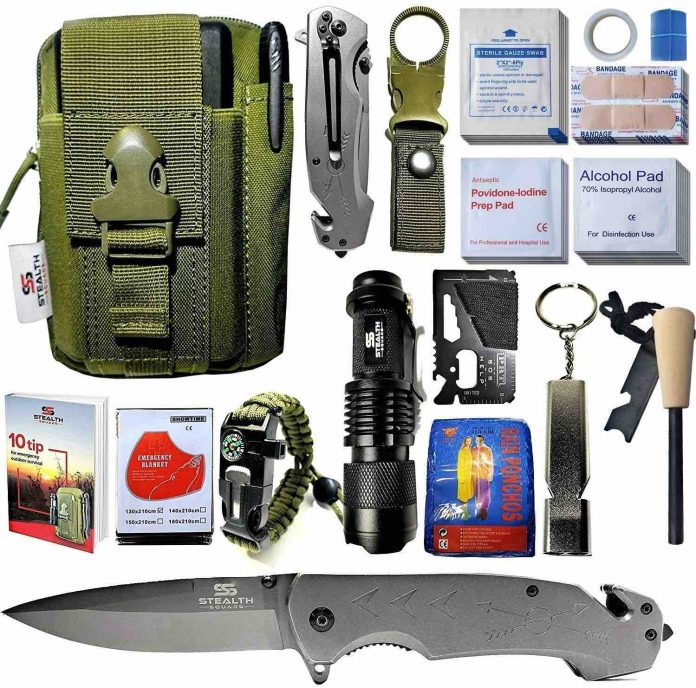In military lingo, “kit” refers to “a set of articles or equipment needed for a specific purpose.” Such as not being helpless if your vehicle stops working – or moving – on account of bad weather or a mechanical failure.
Every vehicle ought to equipped with such kit – for just in case.
The problem is, you’ll have to put one together, yourself – because most modern cars haven’t got any kit at all. Or even a spare tire, in many cases.
Here are some items you might want to have on hand for when just-in-case becomes now what?
What if you find yourself having to walk a distance in rain? Or maintain body heat, in the cold? You can buy survival ponchos and emergency blankets at camping/outfitter stores that fold into almost nothing, so take up next to no space in your vehicle’s cargo area. Some warm gloves/socks/wool hats are a good addition to such kit, along with plastic bags big enough to house your feet. Put them on over your socks, to keep your feet dry (and warm) in the event your shoes get soaked.
Coolant kit –
For you and your car, both of which could overheat one day. Both can be addressed with water, which serves the same purpose as coolant – antifreeze – in a pinch. Since you can’t (well, shouldn’t) drink anti-freeze but your car’s cooling system can “drink” water, keep that rather than a jug of coolant in the back somewhere.
Also a roll of silver duct tape, which is strong enough to contain a leak coming from a radiator hose and keep you mobile. If your car has a serpentine belt driving the accessories – such as the water pump as well as the alternator, air conditioner compressor and power steering pump – buy a spare in advance and keep it with the car. If the old belt frays and breaks, you’ll be good to go. Serpentine belts require almost no tools to install – just the right-sized wrench or socket to lever the idler/tensioner down to remove/install the belt.
Which brings us to . .
Tool kit –
Richard III is said to have said: My kingdom for a horse! – just before Henry II’s men took away his kingdom. Don’t find yourself saying the same over a screwdriver, razor blade or some other minor but critical item.
You can buy kit in this respect that includes a screwdriver with multiple different-sized bits, Phillips and standard. Add a decent little knife or box cutter to this. Some kits come with a set of jumper cables, too. An adjustable wrench and a medium-sized set of vise-grip pliers can also be very handy to have on hand; either can be used to remove/install bolts of various sizes. A flashlight is, of course, essential. And keep the batteries separate. Make sure the batteries aren’t old/dead by checking them annually, at least.
Comms kit –
Most everyone has a sail fawn. But what good is it if you can’t charge the thing? Many cars do have USB/12V charge points. But if your car isn’t running, it isn’t charging. A really handy thing to have on hand is a portable charger for devices such as sail fawns, tablets and so on. These can keep ’em going for a day or longer, without any external power. You can pick up various sizes and types – most about the size of a pack of cigarettes – for less than $50.
Once charged up, these retain power for weeks – even months. Keep one in your glovebox or center console and you’ll be able to call someone for help or just to let them know your situation – even if you forgot to charge up your phone before you found yourself stuck.
Another smart thing to do/keep on hand is a written roster of family/friends’ phone numbers. Many of us no longer memorize these. We have them in our phone’s contact list. But what if they phone goes dark? How are you going to call them if you have no idea what their number is?
Medical kit –
Not “masks” – but a perhaps a box of Band Aids, which actually work.
These are super handy to have on hand when someone gets a cut. It’s not so much about keeping them alive – as no one bleeds to death from a cut and if they are bleeding arterially, you’ll need more than a Band Aid. It’s about keeping them from staining your car’s upholstery. An ace bandage can be used as a tourniquet, in the event of arterial spray.
If you or anyone you’ll be driving takes meds, be sure they have them before you go on a long drive.
Even if you never get stuck, you never know where you might end up – or find yourself in the midst of. Road rage, “peaceful” protests. . . weaponized hypochondriacs. Possibly something worse, given the way the world’s turning.
A firearm is the best sort of kit, but not everyone can or wants to carry that kind of kit. The next-best form of self-defense kit is probably mace – the real stuff, the kind armed government workers carry – not the weak stuff that’s often sold as “mace” but which isn’t very effective. Wasp spray works, too – and it’s great kit because it doesn’t look like mace.
As in, that spare tire so many new cars no longer come standard with. Instead, they come with inflator kits, which work just fine if the tire puncture is in the tread. If the sidewall is punctured, they’re useless. Almost as useless are those “temporary use” spares many new cars have instead of the inflator kit. These feeble things will barely get you going again and often are paired with flimsy – dangerous/inadequate jacking equipment.
It is not a bad idea at all to buy a real (full-size) spare and a sturdy jack/tire iron and throw them in the trunk. They take up room, for sure. But you’ll be glad they did if you ever need them.
The best kit of all is what we who were once Boy Scouts learned as a mantra:
Be prepared.
. . .
Got a question about cars, bikes, or Sickness Psychosis? Click on the “ask Eric” link and send ’em in! Or email me at [email protected] if the @!** “ask Eric” button doesn’t work!
If you like what you’ve found here please consider supporting EPautos.
We depend on you to keep the wheels turning!
Our donate button is here.
If you prefer not to use PayPal, our mailing address is:
EPautos
721 Hummingbird Lane SE
Copper Hill, VA 24079
PS: Get an EPautos magnet or sticker or coaster in return for a $20 or more one-time donation or a $10 or more monthly recurring donation. (Please be sure to tell us you want a magnet or sticker or coaster – and also, provide an address, so we know where to mail the thing!)
My eBook about car buying (new and used) is also available for your favorite price – free! Click here. If that fails, email me at [email protected] and I will send you a copy directly!















eric, been wanting to ask you about this. Not sure if it was covered in the western media (dont watch or follow anymore), but last week in Pakistan in the northern mountainous areas there was a freak snow storm at a popular tourist destination. Unfortunately, the 3 ft of snow in a day, in a country where most cars (or drivers) are not prepared for it meant that there was a really bad traffic jam in a narrow road though a pass – this meant that once jammed there was no way to get out. When it snowed, temperature dropped with people trapped in cars, dozens died, either by suffocating or freezing in their cars.
Im wondering – is there any way to survive that situation? The media coverage is pretty crap out there (well as here as well) but its quite unclear how the died. Some say they froze, some say from the exhaust gases from the engine. So would it be better to get out of the car in a situation like that, or stay in, and risk getting completely snowed in? Also how can one stay warm in a car, once snowed that high ? Personally I think i’d get out and try to walk for help or try to light a fire, but I understand many areas along that stretch meant one couldn’t really walk sideways, just along the road…. it is a really tough one the way I see it.
Hi Nasir,
It depends on the specifics of the situation. Walking is viable, provided you’re dressed for it and fit enough to do it and you know where you are going. Wandering around in a white-out is not sound policy. The best thing is probably to say within the shelter – the car – and stay as warm as possible while you ride it out. Running the engine intermittently (to conserve fuel) should retain enough heat inside to stay alive; if the snow is very deep, one should get out as needed to shovel away snow from the tailpipe area and of course, such that you can still open and close the door to get out and in. If there are multiple people in the car, sit close and combine body heat; it’s hard to do with bucket seats, but the back seats may be better for that. No doubt it’s a tough one… which is why it’s a very good idea to keep essential supplies in the vehicle.
I also carry a tow strap in my car. To help me in case I get stuck. Or I can use it to pull someone else out!
You seem to have overlooked food. I recommend some nuts and multivitamins for cold weather. And a case of curry pouches for warm weather
I’ll add to the other posts. A shovel from the old Soviet Union Army, it is surprisingly better made than the E-tool I carried for years. Fire extinguisher, a brand new empty gallon gas can, very large crowbar, bolt cutters ect. My car EDC is fairly extensive.
An often heard saying in the circles I have traveled in is “Three is two, Two is one, and one is none.” Back-up for everything you carry.
Good basic article Eric! I wonder what the ratio is of people stuck on I-95 that have learned to be better prepared.
Thanks, Manse!
I’ve got one of those compact entrenching tools also. I take it camping. Probably ought to keep it in the truck…
I watched a YT vid on a Soviet-built car from 1988, derided for how styling-wise and in engineering how it was very outmoded when built. While the narrator had a point, he did not the extensive survival and first aid kit included in the trunk, undisturbed since the car rolled out the factory gates, all in Russian. Maybe the Commie Rats at GAZ in “Gorki” (went back to Nzhiny Novogorod in ’92 or so when the USSR dissolved) knew something…
I’ll add to your list a backpacker’s water filter. A jug of water is awesome, but it will run out eventually. A filter provides the ability to turn even swamp water into a drinkable supply. Humans can survive only a few days without water.
Don’t forget fire either. A ferro rod striker and firestarters take up no space and can save your arse in the worst conditions. Cotton balls impregnated with vaseline make incredible firestarters.
EDC is an acronym used by preppers. Every Day Carry refers to kit that you can carry on your person. You can pick up a lot of valuable survival information from preppers. I’ve been following SensiblePrepper on YouTube since I discovered him a few years ago.
Two things I didn’t see mentioned:
An at least 3’x4′ tarp or even a vinyl table cloth. I’ve used several for mega-multiple purposes – but – The number one reason I carry one in my vehicles is to lay down on the ground in front of a flat tire so I don’t get freaking soaked by wet ground or get snow-covered muddy wet while changing a flat.
Do that, & you’ll never get a flat again, eh?
The second is, a foldable shovel. I like the military ones, at least they got that right. I can’t count the times I needed one of those when I was a teenager/twenty-something.
I thought about mine just yesterday when I drove past an empty 4×4 pickup stuck in a deep ditch right alongside a car in the same spot along a curve which had ice on it before I drove by. It seemed obvious to me that all they needed (er, at least the pickup, anyway) was a shovel! Ymmv, I suppose.
Again, Do that, & you’ll never need it, eh?
I’ve read and heard (from Minnesotans) that a bit of non clay kitty litter or a bag of sand is a high priority to carry, but I don’t have any experience with that. It’s probably a very good idea, especially if it’s added weight above the axels.
I stuffed a can of fire starter stuff in the back of my vehicles, to melt snow to drink, I’m not sure if that was worthwhile. I wonder if those stuck on the Interstate have an opinion? I’ve read about the people who lived on ketchup packets & stuff while stranded on the side of the cliff off a turn in the road in Colorado, …so, who knows what you’ll encounter while out & about.
Surviving the elements is hard enough, thank goodness there are no single minded, blinder wearing zombies to add to the mix. Right?
I always used to carry lots of tools plus a floor jack (easier to use then the factory jack), a torque wrench, breaker bar, a separate kit for electrical, wire crimper, crimps, wire, connectors, spare fuses and bulbs, multimeter, code scanner, in one car I have a laptop with diagnostic software with an OBD 2 cable to scan and reset functions, quick ties are also useful, if the car broke down I would just fix it right there if possible.
Lithium ion battery jumpers are new, compact, powerful battery tech that are designed to get you back on the road fast. These also have ports and adapters for charging cell phones or powering 12 volt accessories. Jump start your own car.
Self fusing silicone tape is pretty handy stuff and makes a nice addition to a roadside tool kit.
☮
For those that have cars without spare tires, there are a few companies that sell ‘compact spare’ kits, which is better than having nothing and takes up less room than a full size spare. I made my own kit once for a Ford Focus and it saved my kid a couple times.
When I had an ATS it came with nothing, but since I am usually 3-4hrs away if/when I get a flat, I elected to put a full size spare in the little trunk. Just bought a used rim, and put a new cheapy tire on it.
In my extensive travels over the years, it seems that the majority of flat problems is in the old and poorly maintained ‘rust belt’ region. And now with a lot of cars coming with low-profile tires, the problem was exasperated.
The Jeep Cherokee with Trailhawk package includes a full-size spare. I think at the cost of a smaller fuel tank though. Doesn’t have a rim that matches the normal ones either, so including it in the rotation sequence isn’t possible without looking strange. And the normal rim won’t fit in the spare very well so the cargo floor won’t lay flat. Remembering to check the air pressure seems to be harder than it should be…
Remember when SUVs carried the tire on the back door? Those are the best. Makes it really quick and easy to check or add air. You dont have to pull all of your stuff out of the trunk or put a dirty tire inside the car. It also makes you safer during rear impacts.
After having a blowout with my 2020 Fusion, and discovering to my horror that there’s no spare, just an inflation kit (yeah, LOT of good when the tire’s shredded to hell…), and having to wait HOURS for Ford’s “Roadside Assistance” to actually assist…I’m hunting for an old-fashioned steel wheel and a good used tires as a bona fide spare. May not carry it about town, but if stuck, could keep it at home, and then call #1 son to fetch me to get it and put it on the car. Of course I’d take it with me when leaving town.
Hi Doug,
Yup; been there/done that myself – in press cars! I despise those inflator kits. Totally useless in the event of a sidewall puncture/blowout and those are more likely to happen with these got-damned low-aspect ratio tires now popular.
my car has no spare, I hate that. I carry a plug kit for plugging the hole if needed, and have had to use it once already.
Couple of things to add. One of those yellow construction worker visibility vests or orange hunting vests so other vehicles can see you if you’re walking down a dark road from a stranded vehicle, or working on it on the side of the road.
Also one og those small lithium battery jump-packs. Jumper cables require another vehicle to be present; the battery pack doesn’t.
I keep both of these & a med kit in the truck. Flares too, which are harder to find these days – everyone wants to sell you LED markers, but you can’t start a fire with those if you are in deep doo doo.
Speaking of which, a lighter is good to have.
The li ion packs freeze. The cca is maybe 10. So if you leave them in the trunk for starting the car in 0 degree weather, you may have to warm it up manually before you can start your car. Honestly the fastest way I can think of is putting it down your pants and transferring heat from your thighs for 10 minutes. Keep it clean.
Part of our kit stemmed from when my wife was first diagnosed with Parkinsons. One of her symptoms was her inability to control bodily functions. No big deal. I put together 2 gallon ziplock bags with change of clothes and wet wipes as well as an extra ziplock bag to put the soiled clothes in. The ‘Oops kit’ (what we called it) was in both cars and in her purse.
The lesson being customize for your own situation.
I kept a change of clothes and shoes in my car when I worked in the factories. Sometimes things get messy. Good thing we had a shower.
Leatherman was inspired to design a “Boy Scout knife with pliers” while he and his wife traveled Europe and the Middle East in 1975, often attempting to use a simple pocketknife to repair both their aged and repeatedly malfunctioning Italian Fiat 600 car (bought in Amsterdam for $300) and leaky hotel plumbing.
https://en.wikipedia.org/wiki/Leatherman
Never leave home without your Leatherman. Won’t work for everything, but will work with enough things to be worth having.
I have bought a few over the years.
Comes in handy.
I’m exactly the right age to remember when the “must-have” Scout camp item switched from the Swiss army knife to the Leatherman (or Gerber) multitools.
The pliers can be awfully handy.
Duct tape can also be used as a band aid or tourniquet. I’ve used it for such many times when I worked construction, since I always had some, and most often did not have a band aid. it will temporarily patch up a far more serious wound than a band aid will.
As the fictional Walk Kowalski of “Gran Torino” advised the geeky, socially inept Hmong kid: A roll of duct tape, pair of slip joint pliers, and a can of WD-40, and you can fixed damned near ANYTHING.